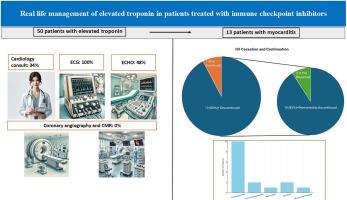Real-Life Management of Elevated Troponin Level in Patients Treated with Immune Checkpoint Inhibitors
IF 2.5
Q2 CARDIAC & CARDIOVASCULAR SYSTEMS
引用次数: 0
Abstract
Background
Immune checkpoint inhibitors (ICIs) have revolutionized the clinical outcomes of cancer. Nevertheless, their use may lead to myocardial injury. The 2022 European Society of Cardiology cardio-oncology guidelines recommend routine follow-up of troponin level; however, current guidelines do not provide specific protocols for managing elevated troponin levels during ICI therapy. We aimed to describe the real-life assessment of patients treated with ICIs, presenting with an elevated high-sensitivity troponin I (hs-TnI) level following therapy.
Methods
Tel Aviv Sourasky Medical Center has implemented a routine follow-up of hs-TnI level measurement during ICI therapy. We performed a retrospective analysis evaluating the clinical assessment and management of patients presenting with an elevated hs-Tnl level (> 50 ng/L) following therapy.
Results
Among 455 patients performing baseline and follow-up hs-TnI measurements, 50 patients (11%) presented with an elevated hs-TnI level (median 159 ng/L; interquartile range 76-362) following ICI therapy. All patients underwent an electrocardiogram, showing changes in 5 patients (10%). Among 24 patients (48%) who received echocardiography, 4 (8%) showed abnormalities. A cardiology consultation was ordered for 17 patients (34%), and none received cardiac magnetic resonance imaging or coronary angiography. A total of 13 patients (26%) were diagnosed with probable or possible myocarditis, resulting in corticosteroid therapy and discontinuation of ICI therapy in 84% and 92% of the patients, respectively. Only 2 patients reinitiated ICI therapy at a later stage.
Conclusions
We describe for the first time the management of elevated hs-TnI levels following ICI therapy, which was diagnosed in routine serial surveillance. We found a wide diversity in management, low cardiology involvement, and high interruption of therapy, emphasizing the need for standardized protocol management guidelines.

免疫检查点抑制剂治疗患者肌钙蛋白水平升高的现实管理
免疫检查点抑制剂(ici)已经彻底改变了癌症的临床结果。然而,它们的使用可能导致心肌损伤。2022年欧洲心脏病学会心脏肿瘤学指南建议对肌钙蛋白水平进行常规随访;然而,目前的指南没有提供在ICI治疗期间处理肌钙蛋白水平升高的具体方案。我们的目的是描述对接受ICIs治疗的患者的现实评估,这些患者在治疗后出现高敏感性肌钙蛋白I (hs-TnI)水平升高。方法特拉维夫苏拉斯基医学中心在ICI治疗期间实施了hs-TnI水平的常规随访。我们进行了一项回顾性分析,评估hs-Tnl水平升高患者的临床评估和管理(>;50 ng/L)。结果在进行基线和随访hs-TnI测量的455例患者中,50例患者(11%)出现hs-TnI水平升高(中位159 ng/L;四分位数范围76-362)。所有患者均行心电图检查,5例患者(10%)出现心电图改变。24例(48%)患者行超声心动图检查,4例(8%)出现异常。17名患者(34%)接受了心脏病学咨询,没有人接受心脏磁共振成像或冠状动脉造影。共有13例患者(26%)被诊断为可能或可能的心肌炎,分别有84%和92%的患者接受了皮质类固醇治疗和停止了ICI治疗。只有2例患者在后期重新开始ICI治疗。结论:我们首次描述了在常规连续监测中诊断出的ICI治疗后hs-TnI水平升高的处理。我们发现在管理上有广泛的多样性,低心脏病学介入,高治疗中断,强调需要标准化的协议管理指南。
本文章由计算机程序翻译,如有差异,请以英文原文为准。
求助全文
约1分钟内获得全文
求助全文
来源期刊

CJC Open
Medicine-Cardiology and Cardiovascular Medicine
CiteScore
3.30
自引率
0.00%
发文量
143
审稿时长
60 days
 求助内容:
求助内容: 应助结果提醒方式:
应助结果提醒方式:


